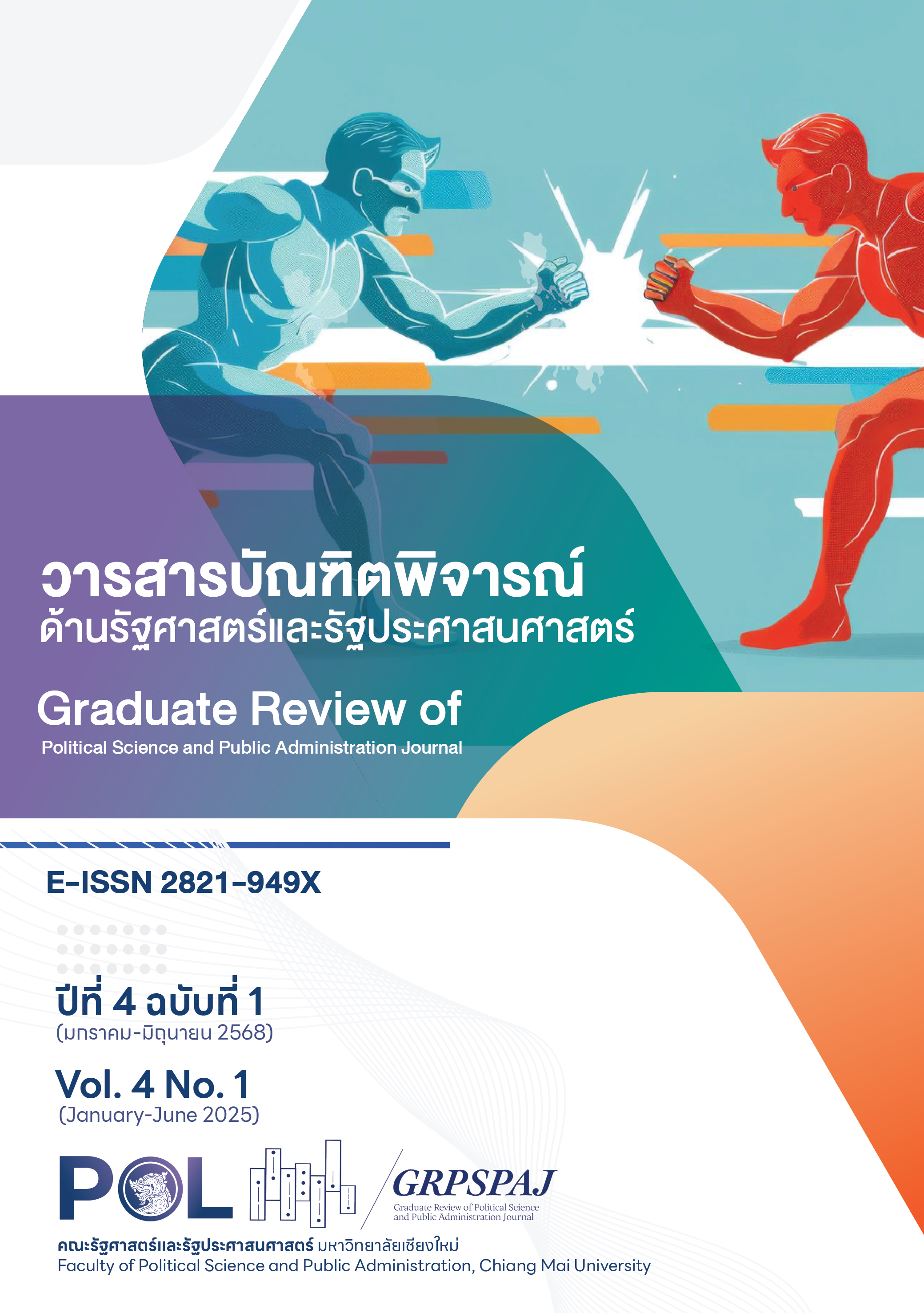การประกอบสร้างความมั่นคงปลอดภัยไซเบอร์ในอาเซียน: ระบอบแห่งความร่วมมือและความเป็นปฏิปักษ์
Main Article Content
บทคัดย่อ
งานวิจัยนี้มีวัตถุประสงค์เพื่อศึกษาตัวแสดงที่เกี่ยวข้องกับการสร้างระบอบความมั่นคงปลอดภัยไซเบอร์ในภูมิภาคอาเซียน (ASEAN) และเพื่อศึกษาปัจจัยและที่มาของการบังคับใช้และการค้ำจุนระบอบความมั่นคงปลอดภัยไซเบอร์ใน ASEAN ผ่านวิธีการวิจัยเชิงคุณภาพด้วยการวิจัยทางเอกสาร โดยจากผลการวิจัยพบว่า ปัจจัยหลักที่เกี่ยวข้องกับกระบวนการสร้างระบอบความมั่นคงปลอดภัยไซเบอร์ในอาเซียน คือ ตัวแสดงที่สร้างความมั่นคง ได้แก่ รัฐสมาชิกอาเซียน องค์การระหว่างประเทศ และองค์การภาคประชาสังคม ซึ่งทำหน้าที่ในการกำหนดถึงสิ่งที่เป็นภัยคุกคามต่อความมั่นคงของภูมิภาค มีอิทธิพลต่อวาทกรรมด้านความมั่นคง และกำหนดแนวทางการแก้ไขปัญหาด้านความมั่นคงปลอดภัยทางไซเบอร์ของอาเซียน และอีกปัจจัยหนึ่ง คือ การตระหนักต่อภัยคุกคามที่มีร่วมกัน ซึ่งในกรณีนี้คือ ภัยคุกคามทางไซเบอร์ ซึ่งเป็นประเด็นที่มีลักษณะข้ามชาติ มีการพัฒนาอยู่เสมอ และกลายเป็นภัยคุกคามที่สร้างผลกระทบต่ออาเซียนทั้งในแง่ของเศรษฐกิจและสังคม รวมถึงสร้างผลกระทบสืบเนื่องให้เกิดภัยคุกคามต่อความมั่นคงด้านอื่นๆ ทำให้อาเซียนจำเป็นต้องพัฒนาความร่วมมือในรูปแบบต่างๆ และทำให้เกิดระบอบความมั่นคงปลอดภัยไซเบอร์ของอาเซียนขึ้นมา อย่างไรก็ตาม ระบอบความมั่นคงปลอดภัยไซเบอร์อาเซียน ไม่ได้มีเพียงแค่ความร่วมมือด้านความมั่นคงปลอดภัยไซเบอร์ แต่แฝงไว้ด้วยความเป็นปฏิปักษ์ด้านความมั่นคงปลอดภัยไซเบอร์ด้วยเช่นกัน ซึ่งเกิดขึ้นมาได้จากหลายปัจจัย ได้แก่ ความแตกต่างในการตีความ ความแตกต่างในการพัฒนา ความขัดแย้งทางการเมือง และบทบาทของมหาอำนาจภายนอกภูมิภาค โดยข้อเสนอแนะของงานวิจัยชิ้นนี้คือ อาเซียนมีความจำเป็นที่จะต้องมีแนวทางร่วมกันในการปรับตัวเพื่อรักษาความมั่นคงและเสถียรภาพ เพื่อให้ระบอบความมั่นคงปลอดภัยไซเบอร์ที่อาเซียนสถาปนาขึ้นสามารถพัฒนาและเติบโตต่อไปได้อย่างมั่นคง เข้มแข็ง และยั่งยืน ทั้งนี้ ผู้ที่มีความสนใจสามารถต่อยอดงานวิจัยชิ้นนี้ โดยศึกษาตัวแสดงที่สร้างความมั่นคงแบบเจาะลึกรายประเทศ หรือศึกษาตัวแสดงมหาอำนาจว่าได้เข้ามามีอิทธิพลและบทบาทในภูมิภาคอาเซียนอย่างไร
Article Details

อนุญาตภายใต้เงื่อนไข Creative Commons Attribution-NonCommercial-NoDerivatives 4.0 International License.
อนุญาตให้สามารถนำไฟล์บทความไปใช้ประโยชน์และเผยแพร่ต่อได้ โดยอยู่ภายใต้เงื่อนไขสัญญาอนุญาตครีเอทีฟคอมมอน (Creative Commons License: CC) โดย ต้องแสดงที่มาจากวารสาร – ไม่ใช้เพื่อการค้า – ห้ามแก้ไขดัดแปลง, Attribution-NonCommercial-NoDerivatives 4.0 International (CC BY-NC-ND 4.0)
เอกสารอ้างอิง
กระทรวงดิจิทัลเพื่อเศรษฐกิจและสังคม. (2562). กระทรวงดิจิทัลฯ ร่วมประชุม รมต. อาเซียนด้านความมั่นคงปลอดภัยไซเบอร์ ที่สิงคโปร์ เดินหน้าบูรณาการร่วมกัน และกำหนดบรรทัดฐานความรับผิดชอบของรัฐบนโลกไซเบอร์. กระทรวงดิจิทัลเพื่อเศรษฐกิจและสังคม. https://www.mdes.go.th/news/detail/1740
ไทยพีบีเอส. (2560). ไทยโดนแล้ว 200 เครื่อง มัลแวร์เรียกค่าไถ่. ThaiPBS. https://www.thaipbs.or.th/news/content/262480
พระราชบัญญัติการรักษาความมั่นคงปลอดภัยไซเบอร์ พ.ศ. 2562. (2562). ราชกิจจานุเบกษา. เล่ม 136 ตอนที่ 69 หน้า 20-51.
สุภชาติ เล็บนาค. (2563). สื่ออาเซียนเผย “Fake News” เกี่ยวกับ "โควิด-19" หลายครั้ง “รัฐ” เผยแพร่เอง. Hfocus. https://www.hfocus.org/content/2020/04/19057
Agence France-Presse. (2024). Sweeping Vietnam Internet Law Comes into Force. Voice of America. https://www.voanews.com/a/sweeping-vietnam-internet-law-comes-into-force/7913333.html
Ang, B. (2018). Next Steps for Cyber Norms in ASEAN. S. Rajaratnam School of International Studies (RSIS). https://www.rsis.edu.sg/rsis-publication/cens/next-steps-for-cyber-norms-in-asean/
Aradau, C. (2004). Security and The Democratic Scene: Desecuritization and Emancipation. Journal of International Relations and Development, 7, 388-413. https://doi.org/10.1057/palgrave.jird.1800030
ASEAN Briefing. (2024). Indonesia's Comprehensive Personal Data Protection Law Guide. ASEAN Briefing. https://www.aseanbriefing.com/doing-business-guide/indonesia/company-establishment/personal-data-protection-law
ASEAN Defence Ministers' Meeting Plus. (2016). Concept Paper on the Establishment of the ADMM-Plus Experts’ Working Group on Cyber Security. ASEAN Defence Ministers’ Meeting (ADMM). https://admm.asean.org/dmdocuments/Concept%20Paper%20on%20Establishment%20of%20EWG%20on%20Cyber%20Security,%20Final,%20as%20adopted%20by%20the%2010th%20ADMM.pdf
ASEAN Foundation. (2023). ASEAN Foundation and Microsoft’s Cybersecurity Skilling Programme Benefited 24,886 People in ASEAN. ASEAN Foundation. https://www.aseanfoundation.org/asean_foundation_and_microsoft_s_cybersecurity_skilling_programmebenefited_24_886_people_in_asean
ASEAN Regional Forum. (2006). ASEAN Regional Forum (ARF) Statement on Cooperation in Fighting Cyber Attack and Terrorist Misuse of Cyber Space. ASEAN Regional Forum https://cil.nus.edu.sg/wp-content/uploads/2019/02/2006-ARF-Statement-on-Cyber-Attack.pdf
ASEAN Regional Forum. (2012). ASEAN Regional Forum (ARF) Statement by the Ministers of Foreign Affairs on Cooperation in Ensuring Cyber Security. ASEAN Regional Forum. https://aseanregionalforum.asean.org/wp-ontent/uploads/2019/01/ARF-Statement-on-Cooperation-in-Ensuring-Cyber-Security.pdf
ASEAN Secretariat. (2017). ASEAN Declaration to Prevent and Combat Cybercrime. The ASEAN Secretariat. https://asean.org/asean-declaration-to-prevent-and-combat-cybercrime/
ASEAN Secretariat. (n.d.). Cyber Security. The ASEAN Secretariat. https://asean.org/our-communities/asean-political-security-community/peaceful-secure-and-stable-region/cyber-security/ASEAN
ASEAN Youth Organization. (2023). ASEAN Cybersecurity Skilling Programme. ASEAN Youth Organization. https://aseanyouth.net/acsp/
ASEAN-Japan Cybersecurity Capacity Building Centre. (2023). ASEAN-Japan Cybersecurity Capacity Building Centre. AJCCBC. https://ajccbc.ncsa.or.th/about-us/
Brandon, J. J. (2018). Why ASEAN Needs to Invest More in Cybersecurity. The Asia Foundation. https://asiafoundation.org/why-asean-needs-to-invest-more-in-cybersecurity/
Buzan, B. (1998). Security: A New Framework for Analysis. Lynne Rienner Pub.
Caballero-Anthony, M. (2016). An Introduction to Non-Traditional Security Studies: A Transnational Approach. Sage Publications.
Cox, R. W. (1996). Approaches to World Order. Cambridge University Press.
Deibert, R. J. (2013). Black Code: Surveillance, Privacy, and the Dark Side of the Internet. Signal.
Ghosh, N. (2019). Singapore's Cyber Security Chief Says International Norms, Partnerships Are Key Issues. The Straits Times. https://www.straitstimes.com/singapore/singapores-cyber-security-chief-says-international-norms-partnerships-are-key-issues
Gohwong, S. (2019). The State of the Art of Cybersecurity Law in ASEAN. Asian Crime and Society Review, 6(2), 12-23. so02.tci-thaijo.org/index.php/IJCLSI/article/view/242594
Hansen, L. (2012). Reconstructing Desecuritisation: The Normative-Political in the Copenhagen School and Directions for How to Apply It. Review of International Studies, 38(3), 525-546. http://www.jstor.org/stable/41681477
Heinl, C. (2014). Regional Cybersecurity: Moving Toward a Resilient ASEAN Cybersecurity Regime. Asia Policy, 18, 131-159. https://dx.doi.org/10.1353/asp.2014.0026
Japan-ASEAN Integration Fund. (2022). Enhancing Cybersecurity Skills of Professionals in ASEAN. JAIF Management Team. https://jaif.asean.org/beneficiaries_voice/enhancing-cybersecurity-skills-of-professionals-in-asean/
Nasu, H., McLaughlin, R., Rothwell, D. R., & Tan, S. S. (2019). The Legal Authority of ASEAN as a Security Institution. Cambridge University Press. https://doi.org/10.1017/9781108669511
Nye, J. S. (2010). Cyber Power. Belfer Center for Science and International Affairs, Harvard Kennedy School. https://www.belfercenter.org/publication/cyber-power
Piiparinen, A. (2016). China’s Secret Weapon in the South China Sea: Cyber Attacks. The Diplomat. https://thediplomat.com/2016/07/chinas-secret-weapon-in-the-south-china-sea-cyber-attacks/
Sunkpho, J., Ramjan, S., & Oottamakorn, C. (2018). Cybersecurity Policy in ASEAN Countries. 17th Annual Security Conference, Information Institute Conferences. Las Vegas, NV.
The Irrawaddy. (2022). Myanmar Junta’s New Cyber Law to Jail Anyone Using VPN. The Irrawaddy. https://www.irrawaddy.com/news/burma/myanmar-juntas-new-cyber-law-to-jail-anyone-using-vpn.html
The Southeast Asia Freedom of Expression Network. (2024). About Us. Southeast Asia Freedom of Expression Network. https://safenet.or.id/about-us/
Van Raemdonck, N. (2021). Cyber Diplomacy in Southeast Asia. EU Cyber Direct. https://eucyberdirect.eu/research/cyber-diplomacy-in-southeast-asia
Waltz, K. N. (1979). Theory of International Politics. Addison-Wesley.
Woollacott, E. (2019). Days After Introduction of 'Cybersecurity' Law, Vietnam Has Facebook in Its Sights. Forbes Magazine. https://www.forbes.com/sites/emmawoollacott/2019/01/09/days-after-introduction-of-cybersecurity-law-vietnam-has-facebook-in-its-sights/
ASEAN. (2021). ASEAN Cybersecurity Cooperation Strategy (2021 – 2025). ASEAN. https://asean.org/wp-content/uploads/2022/02/01-ASEAN-Cybersecurity-Cooperation-Paper-2021-2025_final-23-0122.pdf
Tan, S. S. (2022, March 8). ASEAN Cyber Norms Need Broad Stakeholder Engagement. The Strategist. https://www.aspistrategist.org.au/asean-cyber-norms-need-broad-stakeholder-engagement/
Albahri, D. A. A. (2023, October 5). Women’s Civil Society and Digital Rights Groups Shape South-East Asian Digital Security Training. UN Women Asia-Pacific. https://asiapacific.unwomen.org/en/stories/news/2023/10/womens-civil-society-and-digital-rights-groups

